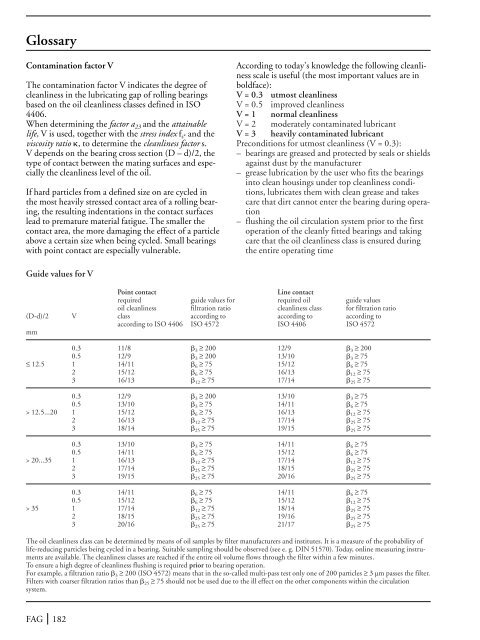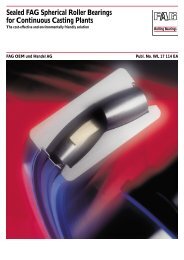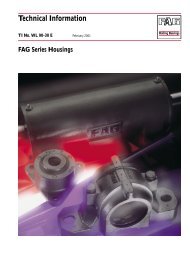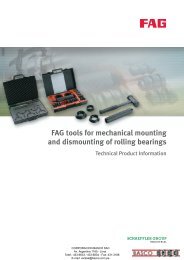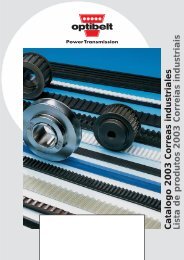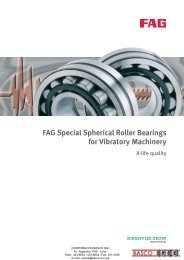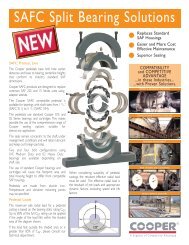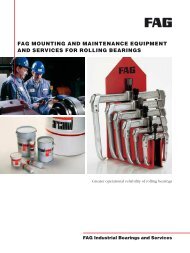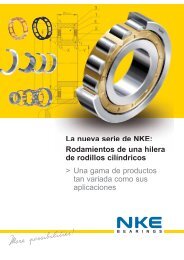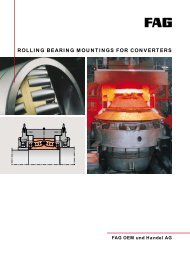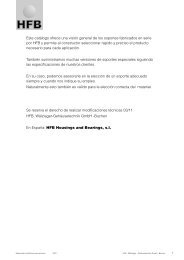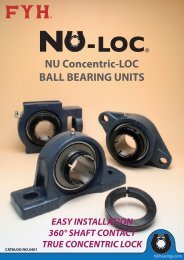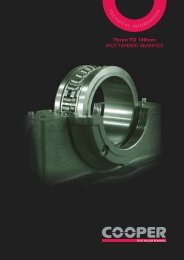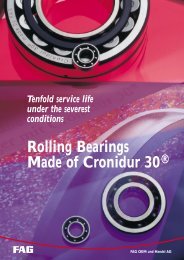Create successful ePaper yourself
Turn your PDF publications into a flip-book with our unique Google optimized e-Paper software.
GlossaryContamination factor V<strong>The</strong> contamination factor V indicates the degree <strong>of</strong>cleanliness in the lubricating gap <strong>of</strong> rolling bearingsbased on the oil cleanliness classes defined in ISO4406.When determining the factor a 23 and the attainablelife, V is used, together with the stress index f s* and theviscosity ratio , to determine the cleanliness factor s.V depends on the bearing cross section (D – d)/2, thetype <strong>of</strong> contact between the mating surfaces and especiallythe cleanliness level <strong>of</strong> the oil.If hard particles from a defined size on are cycled inthe most heavily stressed contact area <strong>of</strong> a rolling bearing,the resulting indentations in the contact surfaceslead to premature material fatigue. <strong>The</strong> smaller thecontact area, the more damaging the effect <strong>of</strong> a particleabove a certain size when being cycled. Small bearingswith point contact are especially vulnerable.According to today's knowledge the following cleanlinessscale is useful (the most important values are inboldface):V = 0.3 utmost cleanlinessV = 0.5 improved cleanlinessV = 1 normal cleanlinessV = 2 moderately contaminated lubricantV = 3 heavily contaminated lubricantPreconditions for utmost cleanliness (V = 0.3):– bearings are greased and protected by seals or shieldsagainst dust by the manufacturer– grease lubrication by the user who fits the bearingsinto clean housings under top cleanliness conditions,lubricates them with clean grease and takescare that dirt cannot enter the bearing during operation– flushing the oil circulation system prior to the firstoperation <strong>of</strong> the cleanly fitted bearings and takingcare that the oil cleanliness class is ensured duringthe entire operating timeGuide values for VPoint contactLine contactrequired guide values for required oil guide valuesoil cleanliness filtration ratio cleanliness class for filtration ratio(D-d)/2 V class according to according to according toaccording to ISO 4406 ISO 4572 ISO 4406 ISO 4572mm0.3 11/8 3 ≥ 200 12/9 3 ≥ 2000.5 12/9 3 ≥ 200 13/10 3 ≥ 75≤ 12.5 1 14/11 6 ≥ 75 15/12 6 ≥ 752 15/12 6 ≥ 75 16/13 12 ≥ 753 16/13 12 ≥ 75 17/14 25 ≥ 750.3 12/9 3 ≥ 200 13/10 3 ≥ 750.5 13/10 3 ≥ 75 14/11 6 ≥ 75> 12.5...20 1 15/12 6 ≥ 75 16/13 12 ≥ 752 16/13 12 ≥ 75 17/14 25 ≥ 753 18/14 25 ≥ 75 19/15 25 ≥ 750.3 13/10 3 ≥ 75 14/11 6 ≥ 750.5 14/11 6 ≥ 75 15/12 6 ≥ 75> 20...35 1 16/13 12 ≥ 75 17/14 12 ≥ 752 17/14 25 ≥ 75 18/15 25 ≥ 753 19/15 25 ≥ 75 20/16 25 ≥ 750.3 14/11 6 ≥ 75 14/11 6 ≥ 750.5 15/12 6 ≥ 75 15/12 12 ≥ 75> 35 1 17/14 12 ≥ 75 18/14 25 ≥ 752 18/15 25 ≥ 75 19/16 25 ≥ 753 20/16 25 ≥ 75 21/17 25 ≥ 75<strong>The</strong> oil cleanliness class can be determined by means <strong>of</strong> oil samples by filter manufacturers and institutes. It is a measure <strong>of</strong> the probability <strong>of</strong>life-reducing particles being cycled in a bearing. Suitable sampling should be observed (see e. g. DIN 51570). Today, online measuring instrumentsare available. <strong>The</strong> cleanliness classes are reached if the entire oil volume flows through the filter within a few minutes.To ensure a high degree <strong>of</strong> cleanliness flushing is required prior to bearing operation.For example, a filtration ratio 3 ≥ 200 (ISO 4572) means that in the so-called multi-pass test only one <strong>of</strong> 200 particles ≥ 3 µm passes the filter.Filters with coarser filtration ratios than 25 ≥ 75 should not be used due to the ill effect on the other components within the circulationsystem.FAG 182


